Country:
Region:
City:
Latitude and Longitude:
Time Zone:
Postal Code:
IP information under different IP Channel
ip-api
Country
Region
City
ASN
Time Zone
ISP
Blacklist
Proxy
Latitude
Longitude
Postal
Route
Luminati
Country
Region
bj
City
beijing
ASN
Time Zone
Asia/Shanghai
ISP
China Mobile Communicaitons Corporation
Latitude
Longitude
Postal
IPinfo
Country
Region
City
ASN
Time Zone
ISP
Blacklist
Proxy
Latitude
Longitude
Postal
Route
db-ip
Country
Region
City
ASN
Time Zone
ISP
Blacklist
Proxy
Latitude
Longitude
Postal
Route
ipdata
Country
Region
City
ASN
Time Zone
ISP
Blacklist
Proxy
Latitude
Longitude
Postal
Route
Popular places and events near this IP address

Meridian Gate
Southern and largest gate of the Forbidden City
Distance: Approx. 372 meters
Latitude and longitude: 39.9125,116.39111111
The Meridian Gate or Wumen (simplified Chinese: 午门; traditional Chinese: 午門; pinyin: Wǔmén; Manchu: ᠵᡠᠯᡝᡵᡤᡳᡩᡠᠯᡳᠮᠪᠠᡳᡩᡠᡴᠠ; Möllendorff: julergi dulimbai duka) is the southern and largest gate of the Forbidden City in Beijing, China. Unlike the other gates of the Forbidden City, the Meridian Gate has two protruding arms on either side, derived from ancient que towers traditionally used to decorate the main entrances of palaces, temples and tombs. The gate has five arches.

Gate of Supreme Harmony
Gate in Beijing, China
Distance: Approx. 491 meters
Latitude and longitude: 39.91397222,116.39075
The Gate of Supreme Harmony (simplified Chinese: 太和门; traditional Chinese: 太和門; pinyin: Tàihémén; Manchu: ᠠᠮᠪᠠᡥᡡᠸᠠᠯᡳᠶᠠᠮᠪᡠᡵᡝᡩᡠᡴᠠ; Möllendorff: amba hūwaliyambure duka) is the second major gate in the south of the Forbidden City in Beijing, China. The gate was originally built during the Ming dynasty, when it was called Fengtianmen (奉天門). Following the Manchu conquest of China, the gate was given its present Chinese and Manchu names.
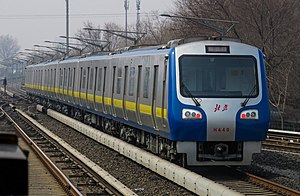
Beijing Subway
Rapid transit system in China
Distance: Approx. 426 meters
Latitude and longitude: 39.9138,116.3916
The Beijing Subway is the rapid transit system of Beijing Municipality that consists of 27 lines including 22 rapid transit lines, two airport rail links, one maglev line and two light rail tram lines, and 490 stations. The rail network extends 836 km (519 mi) across 12 urban and suburban districts of Beijing and into one district of Langfang in neighboring Hebei province. In December 2023, the Beijing Subway became the world's longest metro system by route length, surpassing the Shanghai Metro.
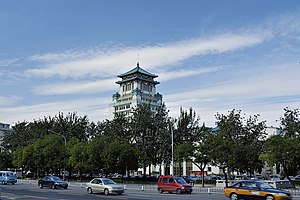
Chang'an Avenue
Road in Beijing, China
Distance: Approx. 418 meters
Latitude and longitude: 39.90757,116.397
Chang'an Avenue (simplified Chinese: 长安街; traditional Chinese: 長安街; pinyin: Cháng'ān Jiē), literally "Eternal Peace Street", is a major thoroughfare in Beijing, China. Chang'an (simplified Chinese: 长安; traditional Chinese: 長安; pinyin: Cháng'ān) is also the old name for Xi'an which was the capital of China during the Western Han dynasty, the Tang dynasty and other periods. The Avenue has also been referred to as the Shili Changjie (simplified Chinese: 十里长街; traditional Chinese: 十里長街; pinyin: Shílǐ Chǎngjiē), meaning the Ten Li Long Street, China's No.
Imperial Ancestral Temple
Building in Beijing, China
Distance: Approx. 170 meters
Latitude and longitude: 39.90996389,116.39354167
The Imperial Ancestral Temple, or Taimiao (simplified Chinese: 太庙; traditional Chinese: 太廟; pinyin: Tàimiào) of Beijing, is a historic site in the Imperial City, just outside the Forbidden City, where during both the Ming and Qing dynasties, sacrificial ceremonies were held on the most important festival occasions in honor of the imperial family's ancestors. The temple, which resembles the Forbidden City's ground plan, is a cluster of buildings in three large courtyards separated by walls. The main hall inside the temple is the Hall for Worship of Ancestors, which is one of only four buildings in Beijing to stand on a three-tiered platform, a hint that it was the most sacred site in imperial Beijing.

Forbidden City Concert Hall
Concert hall in Beijing, China
Distance: Approx. 61 meters
Latitude and longitude: 39.9109,116.3957
Forbidden City Concert Hall (Chinese: 中山公园音乐堂; lit. 'Zhongshan Park Music Hall') is a 1,419-seat multi-purpose venue in Beijing. The name of the venue came from the fact that it is located within the grounds of the Beijing Zhongshan Park, a vast former imperial altar Shejitan and now a public park located to the southwest of the Forbidden City and in the Imperial City.
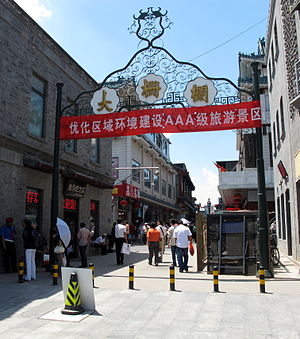
Dashilan Subdistrict
Subdistrict in Xicheng, Beijing
Distance: Approx. 240 meters
Latitude and longitude: 39.90944444,116.39305556
Dashilan Subdistrict (Chinese: 大栅栏街道; pinyin: Dàshilànr Jiēdào) (also known as Dashilanr or Dashilar with Erhua) is a subdistrict on eastern side of Xicheng District, in Beijing, China. Dashilan is also a famous business street outside Qianmen. Now the term Dashilan is also used to refer to the area comprising, besides Dashilan itself, also the Langfang Toutiao Lane, Liangshidian Street and Meishi Street.
Guanganmen incident
Distance: Approx. 429 meters
Latitude and longitude: 39.91388889,116.39166667
The Guang'anmen Incident (Japanese: 広安門事件, Hepburn: Kōanmmon Jiken), or Kuanganmen Incident, was an attack on the Japanese army by the National Revolutionary Army’s 29th Army that occurred on 26 July 1937 in the opening stages of the Second Sino-Japanese War in Beiping, now Beijing, which was the under the control of the Hebei–Chahar Political Council. It occurred following the Marco Polo Bridge Incident of 7 July, and the Langfang Incident of 25 July. At the time, the Chinese army was already amassing in large numbers at Baoding and Shijiazhuang in the southern half of Hebei and at Datong in Shanxi, and had the Japanese army enclosed on all side in the Fengtai District, while on the Japanese side, newly mobilized units of the Kwantung Army and the Japanese Korean Army were in the process of reaching the area of Tianjin and Beiping.
2013 Tiananmen Square attack
Terrorist attack in Beijing, China
Distance: Approx. 433 meters
Latitude and longitude: 39.9075,116.39722222
On 28 October 2013, a car ran over pedestrians and crashed in Tiananmen Square, Beijing, China, in a terrorist suicide attack. Five people died in the incident; three inside the vehicle and two others nearby. Police identified the driver as Usmen Hasan and the two passengers as his wife, Gulkiz Gini, and his mother, Kuwanhan Reyim.
Duanmen
Gate in Beijing, China
Distance: Approx. 408 meters
Latitude and longitude: 39.909,116.391
Duanmen, also known as the Gate of Uprightness, or Upright Gate, is a gate in Beijing's Imperial City. It is located south of the Forbidden City. Proceeding north from the entrance to the Imperial City, it is the next gate after the Tian'anmen, or Gate of Heavenly Peace, and has a similar structure to that gate.
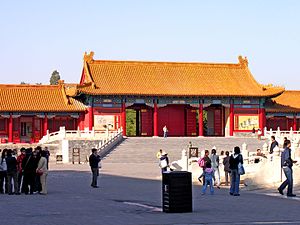
Gate of Glorious Harmony
Historic structure in Beijing, China
Distance: Approx. 407 meters
Latitude and longitude: 39.914592,116.395868
The Gate of Glorious Harmony (simplified Chinese: 熙和门; traditional Chinese: 熙和門; Manchu: ᡳᠵᡳᠰᡥᡡᠨ ᡥᡡᠸᠠᠯᡳᠶᠠᠮᠪᡠᡵᡝ ᡩᡠᡴᠠ ijishūn hūwaliyambure duka), or the Gate of Xihe, Xihemen is a gate sits on the central road of the outer court of the Forbidden Palace. It is on the outer side of the Gate of Supreme Harmony, and eastern to the Gate of Blending Harmony It was first built on the 18th year of Yongle (1420) and was named Gate of Right Obedience. The current building is built on the 23rd year of Qianlong (1758).
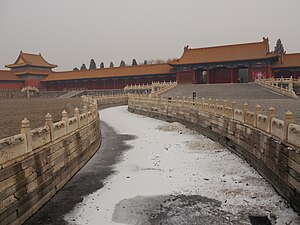
Gate of Blending Harmony
Historic structure in Beijing, China
Distance: Approx. 494 meters
Latitude and longitude: 39.914527,116.398516
The Gate of Blending Harmony (Chinese: 协和门), or the Gate of Xiehe, Xiehemen, is a gate sits on the central road of the outer court of the Forbidden City, outside of the Gate of Supreme Harmony. On the eastern and opposite of the road to the Gate of Glorious Harmony. It was first built in the 18th year of Yongle and named the Gate of Left Obedience.
Weather in this IP's area
clear sky
11 Celsius
9 Celsius
11 Celsius
11 Celsius
1025 hPa
54 %
1025 hPa
1019 hPa
10000 meters
0.41 m/s
1.5 m/s
172 degree
1 %
06:52:27
17:04:07

